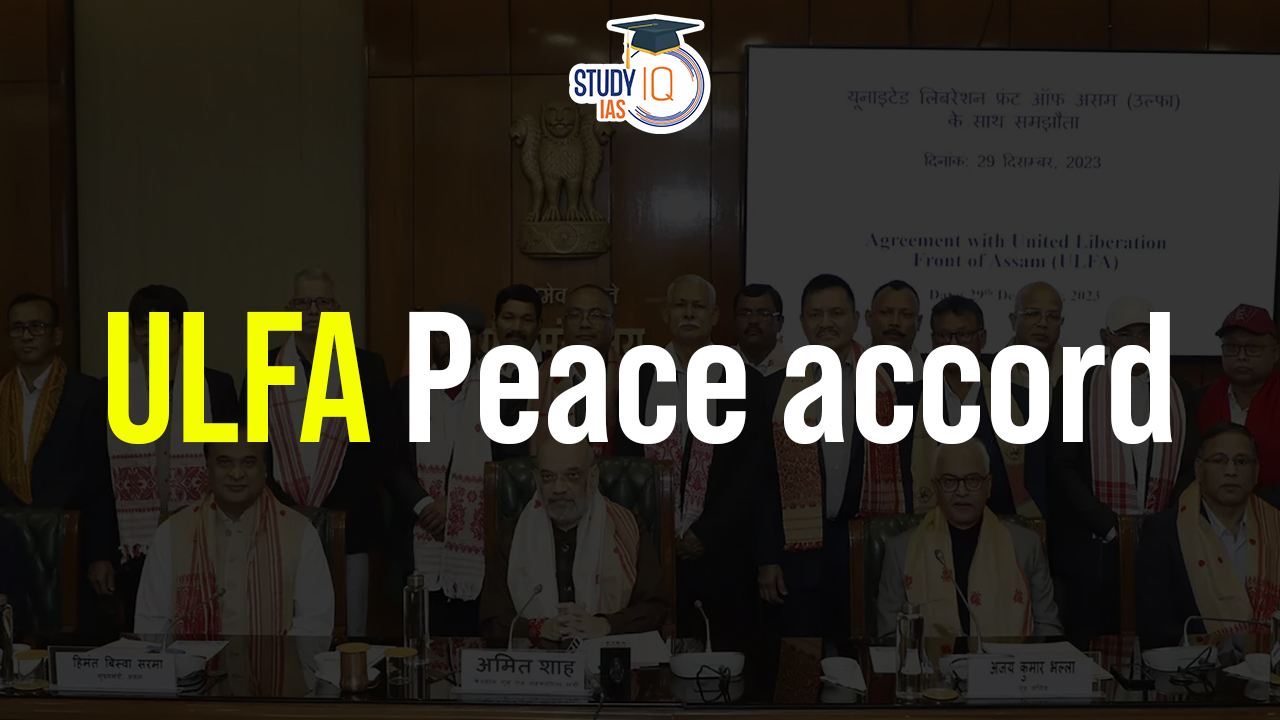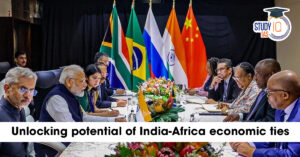Table of Contents
Context: The pro-talks faction of the United Liberation Front of Asom (ULFA) signed a historic tripartite peace deal with the Government of India and the state government of Assam.
About United Liberation Front of Asom (ULFA)
Origin Of ULFA
- The Assam region, with its distinct culture and identity, experienced significant demographic changes starting in the 19th century, due to its burgeoning tea, coal, and oil industries attracting migrants.
- The indigenous population felt increasingly insecure, a situation worsened by Partition and refugee influx from East Pakistan.
- Radical leaders including Bhimakanta Buragohain and others (Arabinda Rajkhowa, Anup Chetia, Pradip Gogoi, Bhadreshwar Gohain and Paresh Baruah) founded ULFA on April 7, 1979.
- ULFA emerged with the aim of creating an independent state for Assamese people, partly as a reaction to the influx of Bengali speakers after the 1971 Bangladesh Liberation War.
- Over 44 years, their struggle involved kidnappings, bombings, and loss of life.
- ULFA established bases in Bangladesh, Bhutan, China, Nepal, and Myanmar for strategic advantage.
- They maintained connections with various insurgent groups in the Northeast and Myanmar, as well as Islamic terror groups like Harkat-ul-Jihad-e-Islami and Al-Qaeda.
We’re now on WhatsApp. Click to Join
Steps Taken by Indian Government
In 1990, the Indian Government declared ULFA a terrorist organisation under the Unlawful Activities (Prevention) Act.
- Launched Operation Bajrang (1990) which has arrested many ULFA insurgents.
- Assam was declared a ‘disturbed area’, the President’s rule was imposed and Armed Forces Special Powers Act (AFSPA) was invoked.
- Strategic measures: It has allegedly supported certain factions of ULFA, like Surrendered ULFA (SULFA) in 1992 which offered to surrender and engage in dialogue with the government.
- Later SULFA allegedly carried out secret killings of ULFA cadres on behalf of the State government.
- Ceasefire by Rajkhowa Faction: The Rajkhowa faction of ULFA entered into a ceasefire agreement with the United Progressive Alliance (UPA) government in 2011 and has been engaged in peace talks with the Central Government since then.
Key Points Of The ULFA Agreement
- ULFA representatives have agreed to cease violence.
- Of the 126 Assembly seats in Assam, 97 will be reserved for indigenous people.
- The government commits to investing ₹1.5 lakh crore in Assam.
- The Ministry of Home Affairs, Government of India, will develop a time-bound program to address ULFA’s demands, and a committee will be established to monitor its implementation.
Note: The agreement was signed with the pro-talks faction of ULFA under Arabinda Rajkhowa while the other faction led by Paresh Baruah (known as ULFA-I) has not joined the peace process.
Towards Peace
- Formation of People’s Consultative Group: In 2005, ULFA established an 11-member ‘People’s Consultative Group’ (PCG), including intellectuals and author Indira Raisom Goswami, to facilitate dialogue.
- Initial Talks and Subsequent Violence: The PCG mediated three rounds of discussions with the government, but ULFA abandoned the talks and initiated a new wave of violence.
- Efforts for Peace by Some Commanders: Starting in 2008, commanders like Arabinda Rajkhowa sought to renew peace negotiations with the government.
- Internal Split and Expulsions: Paresh Baruah, against peace talks, expelled Rajkhowa from ULFA in 2012. In response, the Rajkhowa-led pro-talk faction expelled Baruah, leading to a major split within ULFA.
- Creation of ULFA (Independent): Following the split, Baruah formed his own faction, ULFA (Independent), while the majority pursued peace talks under Rajkhowa’s leadership.
- Submission of Demands by Pro-Talks Faction: In 2012, the Rajkhowa-led faction presented a 12-point charter of demands to the central government.
- Peace Accord: In 2023, a round of discussions between Rajkhowa’s faction and the Centre followed, culminating in the tripartite peace agreement.
Challenges Ahead
- Elusive Lasting Peace: While the recent pact is seen as a positive step, experts caution that true peace requires the participation of Paresh Baruah and remaining ULFA (I) fighters. Their continued absence casts doubt on the agreement’s long-term viability.
- Sovereignty Dispute: Baruah’s insistence on discussing Assam’s sovereignty as a prerequisite for talks poses a significant obstacle. The Indian government’s firm stance against secession creates a major point of contention and hinders progress.
- Baruah’s Location and Influence: Baruah’s remote location in Myanmar hinders direct communication and engagement, making it difficult to reach a resolution. Additionally, his influence within ULFA (I) is crucial, meaning his participation is essential for any lasting peace.
- Potential for Renewed Violence: With Baruah and some fighters still hesitant, the risk of renewed violence remains.
Way Forward
- Rehabilitation Strategy: Focus on reintegrating surrendered insurgents for lasting peace and regional development.
- Inclusive Governance: Adopt an inclusive growth model to enhance trust and transparency at grassroots levels.
- Economic Development: Encourage trade-led industrialization for job creation, growth, and regional integration.
- Education and Integration: Improve education and encourage participation in the national mainstream, particularly in private sector jobs.
- Transparency in AFSPA: Implement greater transparency in the Armed Forces (Special Powers) Act to address concerns.


 Micrometeoroids: Tiny Space Particles, M...
Micrometeoroids: Tiny Space Particles, M...
 India Needs a National Insolvency Tribun...
India Needs a National Insolvency Tribun...
 Unlocking the Potential of India–Afric...
Unlocking the Potential of India–Afric...

























